Concept About Sleep – This book covers the entire syllabus of “Pharmacology” prescribed by BNMC- for diploma in nursing science & midwifery students. We tried to accommodate the latest information and topics. This book is an examination setup according to the teachers’ lectures and examination questions.
At the end of the book, previous questions are given. We hope in touch with the book students’ knowledge will be upgraded and flourish. The unique way of presentation may make your reading of the book a pleasurable experience.

Concept About Sleep
It is a physiological and reversible unconsciousness.
Types: two types
1. Rapid eye movement sleep (REM)
2. Non-rapid eye movement sleep (NREM)
Comparison between REM & NREM Sleep Characteristics
| REM | NREM |
| Paradoxal, Hindbrain, Fast wave irregular low amplitude E.E.G sleep. Increase cerebral circulation above that during wakefulness Paradoxal, Hindbrain, Fast wave irregular low amplitude E.E.G sleep. | Orthodox, Forebrain, Slow wave of high amplitude E.E.G sleep. |
| Awakened person states that he was Dreaming. | Awakened person states that he was relaxed. |
| Heart rate, B.P & respiration are fluctuant | Heart rate. B.P & respiratory are steady. |
| Skeletal muscles are relaxed profoundly. | Muscles are relaxed. |
| Increase cerebral circulation above that during wakefulness | Increase growth hormone & prolactin secretion |
| The penis is erected | Not so. |
Physiological sleep vs drug induced sleep:
| Physiological Sleep | Drug Induced Sleep |
| REM and NREM sleep. | Only NREM sleep |
| Does not produce after effect | Produce after effect: e.g. Headache Lassitude Impaired mood and Impair of judgement |
| PUR-Less respiratory depression | More respiratory depression |
Newer Drugs for Anxiety and Sleep Disorder
A.Buspirone & it’s analogs (ipsasapirone, gepirone. tandospirone)
B. Zolpidem
C.Zaleplonjesi
Buspirone
Buspirone is a non-benzodiazepine anxiolytic drug. It relieves anxiety without causing marked sedation and euphoria.
1. Site of action: 5-HTIA receptor subtype in the brain. Thus produce anxiolytic effect.
2. No influence on interaction of GABA with GABA receptor
3. Rapidly absorbed orally.
4. Undergoes extensive first-pass metabolism.
5. Buspirone seems most effective in mild anxiety and is not effective compared to benzodiazepines and certain anti-depressant agents in treatment of panic disorder.
6. Buspirone does not exhibit cross-tolerance with benzodiazepines or other sedative-hypnotics.
Difference with diazenam (Benzodiazepine)
1. No hypnosis
2. No anticonvulsant activity
3. No muscle relaxant properties.
4. No interaction with benzodiazepine binding sites (no interaction with GABAergic system)
5. Not effective in management of severe anxiety or panic disorder.
6. Minimal adverse effects; produce less psychomotor impairment than benzodiazepines.
Zolpidem
Zolpidem is an imidazopyridine derivative structurally unrelated to benzodiazepines.
1. Have hypnotic actions.
2. Facilitate GABA mediated neuronal inhibition.
3. Minimal muscle relaxing and anticonvulsant effects.
4. May produce amnesia in higher dose.
5. Rapid onset of action.
6. Short duration of action (rapidly metabolized in the liver)
7. Less chance of tolerance and respiratory depression in comparison to conventional benzodiazepines.
Dosages of drugs used commonly for sedation & hypnosis:
| DRUG | DOSAGE |
| For sedation: 1. Alprazolam 2. Buspirone 3. Diazepam 4. Lorazepam 5. Oxazepam 6. Phenobarbital | 1. 0.25-0.5 mg 2-3 times daily 2. 5-10 mg 2-3 times daily 3. 5 mg 2 times daily 4. 1-2 mg once or twice daily 5. 15-30 mg 3-4 times daily 6. 15-30 mg 2-3 times daily |
| For hypnosis: 1. Chloral hydrate 2. Estazolam 3. Flurazepam 4. Lorazepam | 1. 500-1000 mg at bed time 2. 0.5-2 mg at bed time 3. 15-20 mg at bed time 4. 24 mg at bed time |
| 5. Triazolam 6. Zolpidem 7. Secobarbital | 5. 0.125-0.5 mg at bed time 6. 5-10 mg at bed time 7. 100-200mg at bed time |
Alcohol
The word “alcohol” is derived from the Arabic word “alkohi”. It is an organic compound derived from hydrocarbons by substituting one or more hydroxyl (-OH) group for a similar number of hydrogen.
Classification of Alcohol:
1. Monohydroxy alcohol (CH3OH, CH3CH2OH)
2. Dihydroxy alcohol (Ethyl alcohol)
3. Trihydroxy alcohol (Glycerol)
4. Polyhydroxy alcohol (Mannitol, sorbitol).
Ethyl Alcohol
Ethanol occurs naturally as a product of sugar oxidation by yeast. Denatured alcohol is simply ethyl alcohol that has been mixed with toxic or nauseating substances, called denaturants (these prevent the alcohol from being consumed).
Pharmacological action of Alcohol
Alcohol (ethanol) is an unusual sedative, hypnotic and general anaesthetic with a lower extent of safety.
A. CNS: Sedation, Hypnosis, Analgesia, Ataxia Slurred speech Behavioural disturbance anaesthetic effect by direct depression of CNS
B. CVS: Depression of myocardial contractility
C. GIT: Increase tone and motility, Increase gastric secretion.
D. Kidney: Diuresis by inhibiting ADH secretion
E. Respiration: Depression
F. Vessels: Cutaneous vasodilatation
G. Liver: Induction hepatic microsomal enzymes

Absorption of Ethanol
➤ It is highly lipid soluble and is rapidly absorbed from stomach and intestine,
➤ Better absorbed in empty stomach.
➤ It can enter through inhalation also.
➤ Pick plasma level is achieved within 30 min.
➤ Pre-systemic elimination is 10% only.
➤ Rate of absorption depends on:
- Amount of alcohol ingestion.
- Sex.
- Rate at which alcohol is taken
- Speed of absorption.
- Body weight.
- Percentage of total body water.
- Presence of food in the stomach
- amallardealest
- Rate of metabolism of alcohol.
- Rate of excretion.

Metabolism of ethanol (alcohol)
Above 90% of consumed alcohol is oxidized in the liver, the rest is excreted through the lungs & urine alcohol also metabolized in the stomach. Alcohol follows the Zero order kinetics. However, it follows first order kinetics only when taken in small doses. In small dose: Alcohol is metabolized by alcohol dehydrogenase. In high dose: Alcohol is metabolized by M.E.O.S.
Excretion of Ethanol
❖ Ethanol and its metabolites are excreted in urine.
❖ Also excreted by lungs, milk, sweat and saliva.
❖ It can cross the placenta.
Uses of Alcohol
a. Absolute alcohol (injection) relieves pain in carcinoma and trigeminal neuralgia.
b. Rectified spirit (90% alcohol) used as an antiseptic.
c. As a solvent of tincture,
d. To prevent bed sores.
e. To prevent the action of phenol.
Contraindication of Alcohol
a. Epilepsy, because alcohol may bring on convulsionem
b. Pregnancy, because alcohol cause teratogenic effect.
c. Anti-convulsant therapy
d. Diabetes, Gastritis.
Read more:
